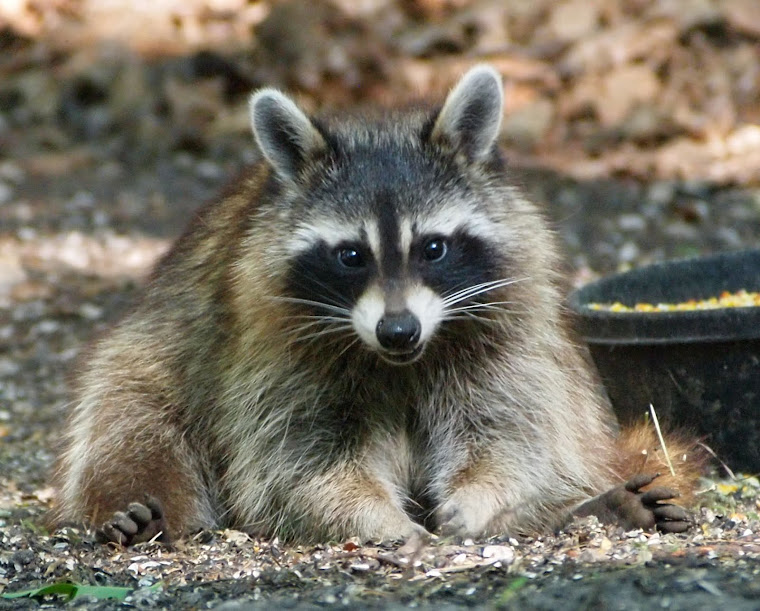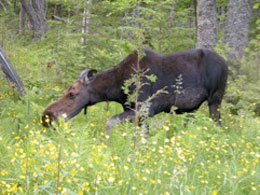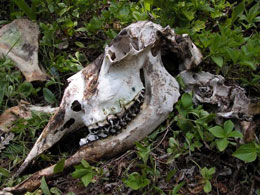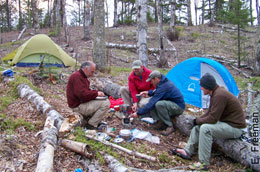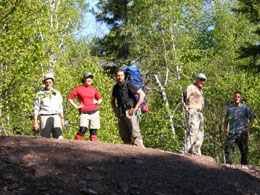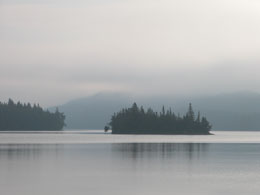WHAT IS A MOOSEWATCH EXPEDITION?
Moosewatch Expeditions are an incredible opportunity for you to be a part of the wolf-moose research project. Each expedition involves a week-long trek though the boreal forests of Isle Royale. The basic purpose of each expedition team is very simple - to carefully search as much area as possible for moose bones. The expedition will also record other important observations and collect other valuable data. You’ll learn about the natural history of Isle Royale and its wilderness ecosystem. Your group will be completely on its own, and out of contact with other people. You will see Isle Royale in a way that very few other people do, and you'll come away with a new understanding of the natural world and how it works.
On the expedition, your team will be guided by a seasoned expedition leader. The team will hike on and off trails through the northern wilderness of Isle Royale, surrounded by the deep blue waters of Lake Superior. This island oasis of spruce and fir is the most remote and least-visited national park in the lower 48 United States. Surrounded by the deep, blue waters of Lake Superior, with no roads or land vehicles, it is a haven for hikers who want to "get away to it all." It also happens to be the best place in the world to learn about moose and wolves.
You will travel through rugged backcountry, using aerial photos, topographic maps, and compasses as your guide, and search for and collect moose bones from winter wolf kills and starved animals. Each moose bone tells a story—of the size, age, and health of the victim and, by extrapolation from many kills on our database, of the moose population at large.
These expeditions are for experienced backpackers only, as you will be hiking up to 16 kilometers a day with a backpack that grows even heavier with moose bones near the end of your hike.
After a challenging hike on and off trail, you'll be glad to set up your tent and cook a simple meal over a single-burner stove. Double tents are encouraged to minimize pack weight, and foods are limited to typical backpacking fare. Despite the lack of variety, it is remarkable how good instant noodles Stroganoff can taste in the waning light of the north woods. At campsites and along the way you may catch glimpses of ospreys, bald eagles, loons, otters, and, of course, moose.
You can be part of this classic study to understand the driving forces behind population booms and crashes. Results of this research have helped turn around public attitudes toward wolves and revolutionize wildlife-management and wolf-reintroduction policies worldwide.
PURPOSE OF THE WOLF-MOOSE PROJECT
The wolf-moose project of Isle Royale is the longest running study of any predator-prey system in the world. The project celebrated its 50th anniversary in 2008.
For more than 50 years, the central purpose of the wolf-moose project has been to better know the wolves and moose of Isle Royale – how they live and die, from day-to-day, across the seasons, and through the years. We aim to better know the behavior, population dynamics, and ecosystem influences of wolves and moose.
The project also works hard to share these discoveries. In doing so, the project also goes far beyond the boundaries of conventional science. The wolf-moose project includes a traveling museum exhibit, art, extensive educational outreach, and a unique opportunity for people like you to be involved in the research.
PURPOSE OF MOOSEWATCH
The wolf-moose project is comprised of both a winter and summer field season. Moosewatch expeditions are a critical component of the summer field season. During the past two decades more than 400 people have contributed to the project by participating in an expedition.
The central objective of Moosewatch is to hike and search as much area as possible for moose bones. The bones of these moose provide a great deal of information: cause of death, age at time of death, year of death, and the condition of the moose at the time death. More that 4300 Isle Royale moose have been discovered and examined. The project curates the world’s largest collection of moose bones. A great deal of what we know about Isle Royale’s moose come from these bones.
Other objectives of Moosewatch expeditions vary, and include observing moose to estimate spring-time, hair loss (which is an indication of ticks having impacted moose), collecting wolf scat for DNA analysis, and more.
In addition to all this activity, you’ll also have time to learn much about the natural history of Isle Royale and its denizens and time to simply enjoy the beauty of nature.
Special note on wolves. – It is very important that you understand that Moosewatch is not intended to be an opportunity to observe wolves. Seeing a wolf during MooseWatch is extremely unlikely. We go out of our way to avoid any kind of interaction with wolves. Isle Royale wolves face a daily struggle in summer to raise growing pups and to stay alive themselves. For these and other reasons, human contact is not desired.
You will, however, be traveling through and living in country where wolves travel and live. Moosewatchers often see wolf tracks, dropping, and other evidence of their presence.
THE NATURE OF MOOSEWATCH
A. Basic Itinerary
On the first day of your expedition you will take a ferry to Isle Royale. You will be greeted at the dock by the Vucetichs and/or the Petersons. Together, we will spend the next several hours at base camp for orientation, training, and packing food and equipment. Then, for one week, you will explore the backcountry in search of moose bones with your team leader. On the afternoon of the eighth day, you will return to base camp where your expedition began. Here you will debrief, record data, shower and enjoy a celebratory banquet. On the final morning, you will board a ferry back to the mainland.
B. Daily Schedule
While traveling through the wilderness, the team will hike together, camping each night in the wilderness. Most daylight hours will be spent moving relatively slowly through the forest, following animal trails and examining areas where moose skeletons are expected to be found. There will be ample time for observing nature and appreciating the wilderness during the course of each day.
The team will travel together with their team leaders, often spread out a bit for maximum coverage. Under the leader’s direction, groups may split briefly (e.g., to cover both sides of a pond). When moose bones are found, the area is searched to find and gather the dispersed bones for examination. A preliminary analysis of the remains will be made at the site. Several bones, including the skull, mandible, and a leg bone, are collected and carried back by the Moosewatchers.
Activities and conditions will vary by expedition. Teams I, II, and III will find somewhat easier hiking because the ground vegetation will just be emerging. This also means greater success in finding moose skeletons. Participants on team IV will encounter much thicker ground vegetation. The earlier expeditions are often challenged by cold temperatures, and the later expedition is often challenged by hot temperatures.
Daily schedules can vary substantially, depending on research needs. Flexibility in this regard is essential.
On some occasions, the team will return to the same camp after a day of hiking. This allows a participant, if they choose, to remain in camp for rest.
Navigation through the wilderness is by topographic maps, aerial photos, and compass. We purposely route Moosewatchers through regions of the island where we’ve not been before or haven’t visited in years. For this reason, it is good to be prepared for the insecure feeling of making mistakes in navigation. Even with decades of experience in this, Rolf and John still manage to get lost at times.
In general, the success of the expedition depends on genuine group effort and a strong team spirit.
C. Low-Impact Backpacking
Isle Royale is a federally-designated wilderness and National Park. According to official, federal policy all activities in such places are expected to adhere to the principles of Leave No Trace. Before the beginning of your expedition, you should familiarize yourself with these principles by visiting the
Leave No Trace website.
DIFFICULTY OF EXPEDITIONS
These expeditions are NOT routine backpacking trips.
The Weight of Your Pack
Usually a pack will weigh somewhat more than 40 pounds when the trip begins. In addition to whatever you put in your pack, we will add 15 to 20 pounds of food and equipment to your pack upon arrival at Isle Royale. Unlike most backpacking trips, these expeditions often end with packs that are considerably heavier than they were at the beginning, because of all the moose bones collected. From a single adult moose skeleton, Moosewatchers may pack up 15 pounds of bones.
Climate and Bugs
Moosewatchers have to deal with whatever conditions Mother Nature brings on. The weather at Isle Royale is variable, so prepare for extremes. When it rains we usually keep walking, so sturdy rain gear (NOT ponchos) is a must. The combination of wet and cold can be pretty uncomfortable! We have timed the expeditions to avoid the heavy insect swarms of mid summer, but expect to see some blackflies and mosquitoes.
Terrain
Most hiking is conducted off-trail. It will be constantly necessary to go over and under fallen trees, work your way through thick vegetation when you can’t see your feet, climb up and down rock ridges, and negotiate bogs and numerous wetlands, all the while keeping a sharp look out for moose bones.
Physical Fitness and Condition
It is absolutely essential that participants be in excellent physical condition. Signing-up for an expedition will require your doctor to sign a form that describes the nature of this expedition and indicates that you are in appropriate physical condition for such a trip.
Weather Considerations
Your Expedition will deal with whatever conditions Mother Nature brings on. The weather at Isle Royale is variable, so prepare for extremes. When it rains, we usually keep walking so sturdy rain gear (NOT ponchos) is a must. Typical temperatures in May are in the mid-50s F (12-14C) during the day and the mid-30sF (0-3C) at night. Average temperatures in June are slightly higher. In August, high temperatures are in the upper 60sF (19-21C) and typical lows are in the mid 50s (12-14C). Normal precipitation in May/June is around three inches (7.6 cm), usually in the form of rainfall, though snow is possible. Average August precipitation is slightly higher. Humidity can be very high or very low. Volunteers on all teams must be prepared to experience all types of weather – hot, cold, dry, snowy, wet, and windy. We have timed the Expeditions to avoid the heavy insect swarms of mid-summer, but expect to see some black flies and mosquitoes.
OTHER IMPORTANT INFORMATION
Food
All the food that you will need, while on Isle Royale, will be provided. Moreover, there will not be an opportunity to purchase food on Isle Royale. Most food is shipped to the island weeks in advance. Cook kits, stoves, all food, and a water filter will be provided. Meals will be simple. You will be carrying all of your food and the equipment necessary to prepare it. Meals will also be heavy in carbohydrates, soy protein, and high energy foods, such as nuts, raisins, chocolate, cheese, etc. You will be filtering (or boiling) all of your drinking water. Breakfasts and dinners are cooked over single burner gas stoves. Breakfast and dinner also include a hot beverage (coffee, cocoa, tea). Breakfast also includes Tang (orange-flavored, powdered drink mix).
Below are examples of the food you can expect in the field. This list only provides a general idea of food types. It is very important to be flexible.
Breakfast: Granola and flavored, instant oatmeal
Lunch: Usually a mix of cheese, peanut butter, raisins, crackers, chocolate, & “gorp” (granola, oats, raisins, peanuts, M&Ms)
Dinner: Usually involving something like Lipton “instant” meals, supplemented with dehydrated vegetables, soy protein, and powdered milk, plus instant pudding
Regrettably, we are unable to accommodate volunteers who cannot eat dairy products. Milk powder and cheese are major sources of protein and calories in the field and are included in the premixed meals. Accommodating special diets is not guaranteed; indicate any dietary restrictions on the application form.
How to Pack
Bring two bags. One bag must be a backpack suitable to carry everything needed in the field. A second bag is for clean clothes and items you will leave behind at base camp. Do not bring more luggage than you can carry and handle on your own.
All your food and equipment must be carried in a single backpack, so choose light weight items. Bring clothing that can be layered to suit the conditions. Plan carefully so you have what need, but no more.
For a detailed check list of all that you should bring, click
here.
Accommodations and Facilities
You will be traveling in the wilderness and accommodations will be primitive. You will be working and camping apart from other people and all modern facilities. You will not have electricity, running water, flush toilets, internet access, telephone access, or cell phone reception. Do not expect flush toilets. Even outhouses will be largely unavailable.
While in the backcountry (Days 1-7), opportunities to clean-up are modest. Soap and other products must not be used in or near any bodies of water – even so-called biodegradable products. Consequently, cleaning-up is limited to splashing off with small containers of water brought up and away from shorelines.
On day 8 of the Expedition, when you return from the backcountry, you will be able to take a “country shower” upon return from the trip – water will be heated on a stove and taken into a tarped enclosure. You should bring your own towel and soap.
Additional information is also provided when we receive your application.
